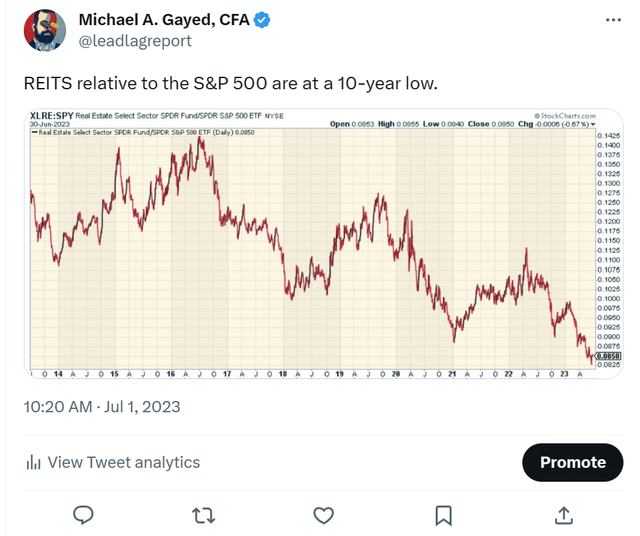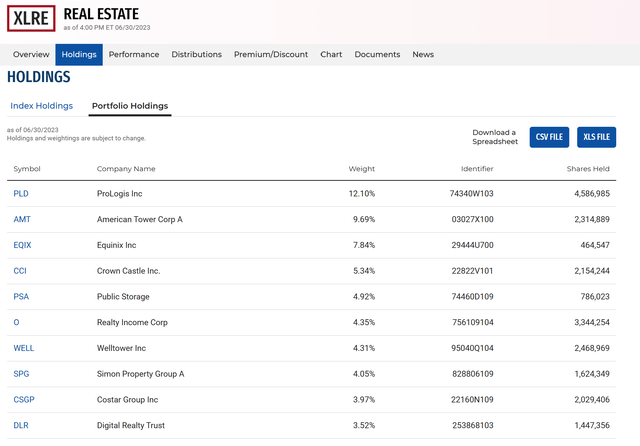“The best time to buy a home is always five years ago.” – Ray Brown
Despite the potential for markets to go lower, a lot of bad news has been priced into REITs in general, making it potentially attractive now for the long-run. The Real Estate Select Sector SPDR ETF (NYSEARCA:XLRE) relative to the S&P 500 (SPY) is at a 10-year low, which makes it interesting to me as someone who likes to look for new secular leaders. The trend is still lower, but is there a case to be made for true long-term investors now with higher rates?
Twitter
What are REITs?
A Real Estate Investment Trust (REIT) is a company that owns, operates, or finances income-generating real estate. Modeled after mutual funds, REITs pool the capital of numerous investors. This makes it possible for individual investors to earn dividends from real estate investments—without having to buy, manage, or finance any properties themselves.
The Attraction of REITs
The key allure of REITs lies in their unique structure and tax advantages. REITs are required by law to distribute at least 90% of their taxable income to shareholders annually in the form of dividends. This directive is the primary reason why REIT dividends are generally higher than many other stocks, making them an appealing choice for income-oriented investors.
The Two Broad Types of REITs
REITs primarily fall into two categories: Equity REITs and Mortgage REITs.
- Equity REITs own and manage real estate properties. They earn income from collecting rent on, and from the sale of, the properties they own for the long term.
- Mortgage REITs (mREITs), on the other hand, deal in investment and ownership of property mortgages. These REITs loan money to real estate owners, or purchase existing mortgages or mortgage-backed securities. Their revenues are generated primarily by the interest that earned on these investments.
The Case for Investing in REITs
Despite the common perception of REITs being risky due to their sensitivity to interest rates, several factors make them an attractive investment option right now despite my overall skepticism around housing and commercial real estate.
Firstly, REITs typically offer higher dividends than many other investments, providing a steady income stream for investors. This makes them particularly appealing to income-focused investors. And with AI mania gone wild, the pendulum will eventually swing back to income from capital appreciation.
Secondly, REITs provide an opportunity for portfolio diversification. They have a low correlation to other stocks and bonds, which means they can help reduce portfolio risk.
NAREIT
Lastly, REITs offer the potential for capital appreciation. The value of the properties within a REIT can increase over time, leading to an increase in the price of the REIT’s shares. I don’t suspect this will be a major driver given broader property weakness I believe is very early, but I could be wrong and maybe those property values continue their ascent.
The Contrarian Perspective on REITs
The recent downturn in the real estate market, coupled with rising interest rates, has led to a widespread bearish outlook on REITs, particularly given concerns around commercial real estate. However, it’s worth considering that much of the negative news may already be priced into REITs, potentially making them an attractive investment for the long run.
Investing in REITs: The XLRE ETF
The Real Estate Select Sector SPDR ETF (XLRE) is a market-cap-weighted fund that tracks a range of REITs and real estate stocks, excluding mortgage REITs, from the S&P 500. It offers investors an opportunity to tap into the growth and income potential of the U.S. real estate sector at a relatively low cost.
State Street
As of the latest data, XLRE’s top holdings include Prologis (PLD), American Tower (AMT), Equinix (EQIX), Crown Castle (CCI), and Public Storage (PSA). These companies represent a mix of different real estate classes, contributing to the fund’s diversification.
REITs and Interest Rates: A Complex Relationship
It’s a common perception that REITs underperform when interest rates rise. However, the relationship between REITs and interest rates is more complex than it appears. While higher interest rates increase the cost of borrowing for REITs, they also usually signal a strong economy—which can be beneficial for real estate. Moreover, many REITs have the ability to pass on higher costs to tenants through rent increases.
Pitfalls to Avoid When Investing in REITs
Like any investment, investing in REITs also comes with its share of risks. One of the significant risks associated with REITs is their high debt load. REITs often finance their acquisitions through substantial borrowing, which can amplify losses during market downturns. Hence, it’s crucial for investors to examine a REIT’s balance sheet and assess its debt levels before investing.
Another risk comes from the potential for unsustainable dividends. REITs that offer unusually high dividend yields could be over-distributing and might not be able to maintain their dividend payments in the long run.
Final Thoughts
While the real estate sector is currently facing several headwinds, REITs — particularly diversified ETFs like XLRE — could potentially offer a compelling investment opportunity. With their high dividends and potential for capital appreciation, REITs can serve as a valuable addition to a well-diversified investment portfolio, and while weakness remains in place, it’s worth considering nibbling now in the space.
Read the full article here












